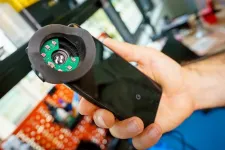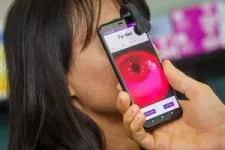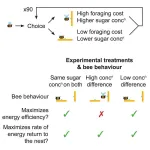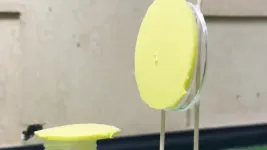(Press-News.org) Engineers at the University of California San Diego have developed a smartphone attachment that could enable people to screen for a variety of neurological conditions, such as Alzheimer’s disease and traumatic brain injury, at low cost—and do so accurately regardless of their skin tone.
The technology, published in Scientific Reports, has the potential to improve the equity and accessibility of neurological screening procedures while making them widely available on all smartphone models.
The attachment fits over a smartphone’s camera and improves its ability to capture clear video recordings and measurements of the pupil, which is the dark center of the eye. Recent research has shown that tracking pupil size changes during certain tasks can provide valuable insight into an individual’s neurological functions. For example, the pupil tends to dilate during complex cognitive tasks or in response to unexpected stimuli.
However, tracking pupil size can be difficult in individuals with dark eye colors, such as those with darker skin tones, because conventional color cameras struggle to distinguish the pupil from the surrounding dark iris.
To enhance the visibility of the pupil, UC San Diego engineers equipped their smartphone attachment with a specialized filter that selectively permits a certain range of light into the camera. That range is called far-red light—the extreme red end of the visible spectrum located just before infrared light. Melanin, the dark pigment in the iris, absorbs most visible wavelengths of light but reflects longer wavelengths, including far-red light. By imaging the eye with far-red light while blocking out other wavelengths, the iris appears significantly lighter, making it easier to see the pupil with a regular camera.
“There has been a large issue with medical device design that depends on optical measurements ultimately working only for those with light skin and eye colors, while failing to perform well for those with dark skin and eyes,” said study senior author Edward Wang, an electrical and computer engineering professor in The Design Lab at UC San Diego, where he is the director of the Digital Health Technologies Lab. “By focusing on how we can make this work for all people while keeping the solution simple and low cost, we aim to pave the way to a future of fair access to remote, affordable healthcare.”
Another feature of this technology that makes it more accessible is that it is designed to work on all smartphones. Traditionally, pupil measurements have been performed using infrared cameras, which are only available in high-end smartphone models. Since regular cameras cannot detect infrared light, this traditional approach limits accessibility to those who can afford more expensive smartphones. By using far-red light, which is still part of the visible spectrum and can be captured by regular smartphone cameras, this technology levels the playing field.
“The issue with relying on specialized sensors like an infrared camera is that not all phones have it,” said study first author Colin Barry, an electrical and computer engineering Ph.D. student in Wang’s lab. “We created an inexpensive and fair solution to provide these kinds of emerging neurological screenings regardless of the smartphone price, make or model.”
To use the attachment, a person clips it over a smartphone’s camera and places it over their eye. Then, the smartphone administers a pupil response test by providing a flash of bright light and recording video of the eye during the test. A machine learning model uses the recorded video of the eye to track pupil size.
The researchers tested their smartphone attachment on a diverse group of 12 volunteers with a wide range of eye colors, from light blue to dark brown. The smartphone measurements were validated against a pupillometer, the gold standard device used in the clinic for measuring pupil size.
The next phase of this project involves taking steps towards deploying the technology for large-scale neurological screenings in at-home environments. To reach that stage, the researchers are working on optimizing the design for mass manufacturing. They are also making the technology more user friendly, especially for older adults given their elevated risk for developing neurological conditions.
Wang and Barry have co-founded a company, Billion Labs Inc., to refine and commercialize the technology.
Paper: “Racially fair pupillometry measurements for RGB smartphone cameras using the far red spectrum.”
This work is supported by the National Institute of Aging.
Disclosures: Edward Wang and Colin Barry are co-founders of and have a financial interest in Billion Labs Inc. Wang is also the CEO of Billion Labs. The terms of this arrangement have been reviewed and approved by the University of California San Diego in accordance with its conflict-of-interest policies.
END
Smartphone attachment could increase racial fairness in neurological screening
2023-10-24
ELSE PRESS RELEASES FROM THIS DATE:
New methods for effective transport of large genes in gene therapy
2023-10-24
Gene therapy currently represents the most promising approach for the treatment of hereditary diseases. Yet despite significant breakthroughs in recent years, there are still a number of hurdles that hinder the wider application of gene therapies. These include the efficient delivery of genetic material into target cells with minimal side effects using adeno-associated viral vectors (AAVs). The AAV carrier substances have an advantageous safety profile and high gene transfer efficiency, meaning they are often used in gene therapies and in gene editing with CRISPR/Cas. But, AAVs have limited DNA uptake capacity ...
New tool may flag signs of pandemic-related anxiety and depression in healthcare workers
2023-10-24
An artificial intelligence tool effectively detected distress in hospital workers’ conversations with their therapists early in the pandemic, a new study shows, suggesting a potential new technology that screens for depression and anxiety.
As the coronavirus pandemic forced many hospitals to operate beyond capacity, medical workers faced overwhelming numbers of work shifts, limited rest, and increased risk of COVID-19 infection. At the same time, quarantine policies and fear of infecting family reduced their ...
Bumblebees visit flowers with more difficult-to-access nectar for immediate benefit to the colony
2023-10-24
If you’ve ever watched a bumblebee move from flower to flower, you might wonder how they decide which flower to choose and how long to stay. Now, researchers reporting in the journal iScience on October 24 have new insight based on their observations of bumblebees’ interactions with slippery artificial flowers. They found that the bumblebees make choices to maximize the rate of energy return, or the amount of sugar collected each minute.
“Bumblebees can make decisions ‘on the fly’ about which nectar sources are the most energetically economical,” said Jonathan ...
Making chemistry more accessible at the University of Oxford by providing period products
2023-10-24
When it comes to the question of who gets to be a scientist, gender disparities are well-documented in many fields. Patching the infamous “leaky pipeline” can be a thorny problem, but during the 2022–2023 school year, the Department of Chemistry at the University of Oxford took a simple and practical step forward: they began offering period products in the department’s bathrooms. In an article publishing October 25 in the journal Trends in Chemistry, three students involved in the Oxford Period Project and their supervising ...
Traditional chinese medicine compound (tongxinluo) and clinical outcomes of patients with acute myocardial infarction
2023-10-24
About The Study: In this randomized clinical trial of 3,777 patients with ST-segment elevation myocardial infarction (STEMI; a type of heart attack), the Chinese patent medicine Tongxinluo, as an adjunctive therapy in addition to STEMI guideline-directed treatments, significantly improved both 30-day and 1-year clinical outcomes. Further research is needed to determine the mechanism of action of Tongxinluo in STEMI.
Authors: Yuejin Yang, M.D., Ph.D., and Runlin Gao, M.D., of the Chinese Academy of Medical ...
Getting maximum calories in shortest time is the priority for bumblebees
2023-10-24
Research has found that bumblebees make foraging choices to collect the most sugar from flowers in the shortest time – even if that means using more energy in the process – to provide an immediate energy boost for the colony.
A new study investigating nectar drinking in one of the most common bumblebees in the UK, Bombus terrestris, has found that when foraging they maximise the amount of nectar sugar they take back to the colony each minute.
To make their choices, the bumblebees trade off the time they spend collecting nectar with the energy content of that nectar. This means ...
Incidence and transmission of SARS-CoV-2 in child care centers after COVID-19 vaccines
2023-10-24
About The Study: In this examination of SARS-CoV-2 incidence and transmission in child care centers (CCCs) and students’ households, transmission within CCCs and from children infected at CCCs into households was low in this study that included 83 children in 11 CCCs. These findings suggest that current testing and exclusion recommendations for SARS-CoV-2 in CCCs should be aligned with those for other respiratory viruses with similar morbidity and greater transmission to households.
Authors: Timothy R. Shope, ...
Neurodevelopmental outcomes among offspring exposed to corticosteroid and B2-adrenergic agonists in utero
2023-10-24
About The Study: The results of this study of 91,460 mother-offspring pairs found no association between in utero corticosteroid and β2-adrenergic agonist exposure and offspring neurodevelopmental outcomes, regardless of the timing of exposure. Despite the limitations and low power of the study, the findings suggest that corticosteroids and β2-adrenergic agonists are safe for pregnant individuals with asthma and the neurodevelopment of their offspring.
Authors: Abir Nagata, Ph.D., of Osaka University in Osaka, Japan, and Toshio Masumoto, Ph.D., of Tottori University ...
Child care centers unlikely source for COVID-19 transmission, study finds
2023-10-24
Children in child care centers are not spreading COVID-19 at significant rates to caregivers or other children at the center, nor to their households, according to a study led by University of Pittsburgh School of Medicine and UPMC Children’s Hospital of Pittsburgh pediatrician-scientists and published today in JAMA Network Open.
The findings suggest that recommendations to test symptomatic children for SARS-CoV-2, the virus that causes COVID-19, and keep positive children home from child care for prolonged periods can be revised to align with those for other serious ...
Pew funds 6 teams to advance cutting-edge biomedical research
2023-10-24
PHILADELPHIA—The Pew Charitable Trusts announced today the six pairs of researchers who will make up its 2023 class of Innovation Fund investigators.
These 12 acclaimed scientists—all alumni or advisors of Pew’s biomedical programs in the United States and Latin America—will partner on interdisciplinary research projects exploring key questions in human biology and disease. Combining the researchers’ expertise in topics ranging from neuroscience and immunology to cancer biology, these collaborations will help boost scientific discovery and improve human health.
“An interdisciplinary approach to research is critical to uncovering scientific breakthroughs ...





